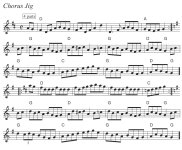SteveBox
Well-known member
I switched from PA to CBA two decades ago, and I understand what Gary is trying to say, but I would disagree. It is easier, perhaps, on a PA to do those rapid repetitions, but with practice, your aim improves, and you can do them just fine on a CBA. And, if sometimes one of your fingers brushes against an adjacent button in a rapid repeat, the notes are so short in duration that it makes no difference to the effect and may even sound more interesting.Fast repetition of a note requires striking the same key with different fingers in succession... and his "secret weapon" is laying his fingertips along the length of a piano key such that one finger is ready to strike the instant the previous one lifts, without having to wait until the first finger moves completely out of the way. That doesn't work on a button accordion because the button is such a small target, with other buttons above and below it.
There is more to fast playing than just rapid repeats. How about the fact that the buttons on a CBA are spaced closer together than keys on a PA, so your fingers move shorter distances. That must make it easier on a CBA to play some fast musical phrases. I would conclude that in general, neither a PA nor a CBA is faster than the other, but for certain music it might be easier to play it fast on one vs. the other.

